Hongbo Zhu
Representation Understanding via Activation Maximization
Aug 10, 2025Abstract:Understanding internal feature representations of deep neural networks (DNNs) is a fundamental step toward model interpretability. Inspired by neuroscience methods that probe biological neurons using visual stimuli, recent deep learning studies have employed Activation Maximization (AM) to synthesize inputs that elicit strong responses from artificial neurons. In this work, we propose a unified feature visualization framework applicable to both Convolutional Neural Networks (CNNs) and Vision Transformers (ViTs). Unlike prior efforts that predominantly focus on the last output-layer neurons in CNNs, we extend feature visualization to intermediate layers as well, offering deeper insights into the hierarchical structure of learned feature representations. Furthermore, we investigate how activation maximization can be leveraged to generate adversarial examples, revealing potential vulnerabilities and decision boundaries of DNNs. Our experiments demonstrate the effectiveness of our approach in both traditional CNNs and modern ViT, highlighting its generalizability and interpretive value.
Revisiting Data Attribution for Influence Functions
Aug 10, 2025Abstract:The goal of data attribution is to trace the model's predictions through the learning algorithm and back to its training data. thereby identifying the most influential training samples and understanding how the model's behavior leads to particular predictions. Understanding how individual training examples influence a model's predictions is fundamental for machine learning interpretability, data debugging, and model accountability. Influence functions, originating from robust statistics, offer an efficient, first-order approximation to estimate the impact of marginally upweighting or removing a data point on a model's learned parameters and its subsequent predictions, without the need for expensive retraining. This paper comprehensively reviews the data attribution capability of influence functions in deep learning. We discuss their theoretical foundations, recent algorithmic advances for efficient inverse-Hessian-vector product estimation, and evaluate their effectiveness for data attribution and mislabel detection. Finally, highlighting current challenges and promising directions for unleashing the huge potential of influence functions in large-scale, real-world deep learning scenarios.
Extract-and-Abstract: Unifying Extractive and Abstractive Summarization within Single Encoder-Decoder Framework
Sep 18, 2024



Abstract:Extract-then-Abstract is a naturally coherent paradigm to conduct abstractive summarization with the help of salient information identified by the extractive model. Previous works that adopt this paradigm train the extractor and abstractor separately and introduce extra parameters to highlight the extracted salients to the abstractor, which results in error accumulation and additional training costs. In this paper, we first introduce a parameter-free highlight method into the encoder-decoder framework: replacing the encoder attention mask with a saliency mask in the cross-attention module to force the decoder to focus only on salient parts of the input. A preliminary analysis compares different highlight methods, demonstrating the effectiveness of our saliency mask. We further propose the novel extract-and-abstract paradigm, ExtAbs, which jointly and seamlessly performs Extractive and Abstractive summarization tasks within single encoder-decoder model to reduce error accumulation. In ExtAbs, the vanilla encoder is augmented to extract salients, and the vanilla decoder is modified with the proposed saliency mask to generate summaries. Built upon BART and PEGASUS, experiments on three datasets show that ExtAbs can achieve superior performance than baselines on the extractive task and performs comparable, or even better than the vanilla models on the abstractive task.
Noise-Free Explanation for Driving Action Prediction
Jul 08, 2024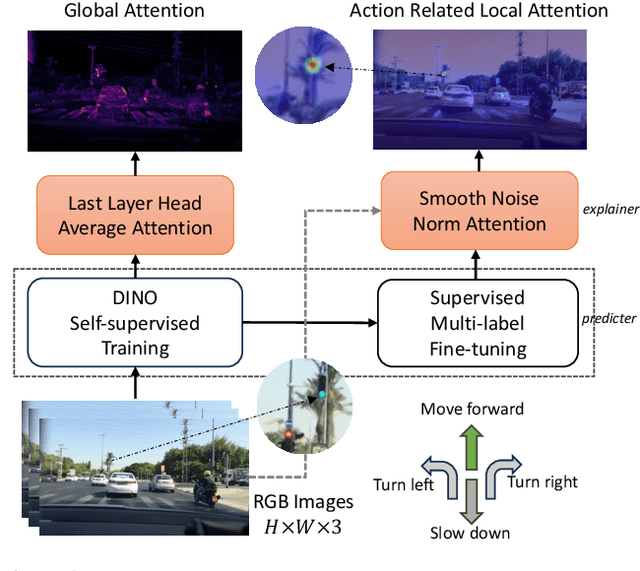

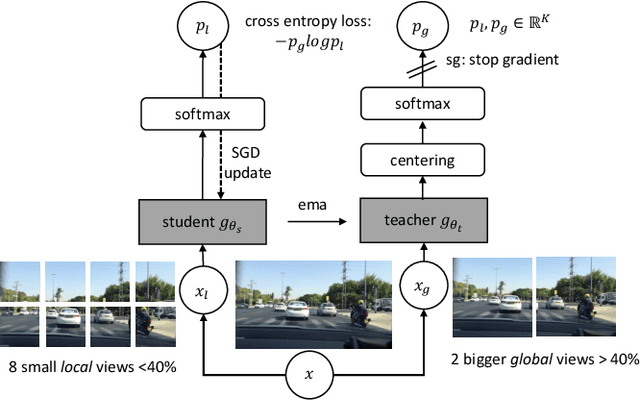
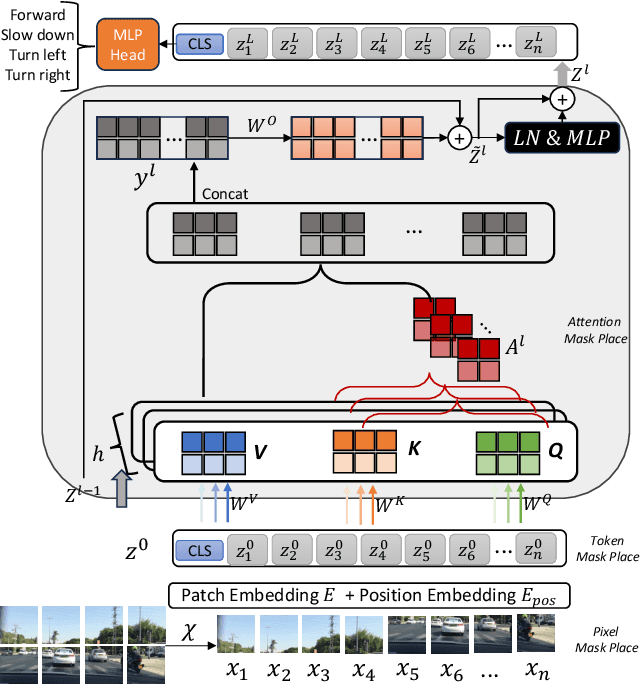
Abstract:Although attention mechanisms have achieved considerable progress in Transformer-based architectures across various Artificial Intelligence (AI) domains, their inner workings remain to be explored. Existing explainable methods have different emphases but are rather one-sided. They primarily analyse the attention mechanisms or gradient-based attribution while neglecting the magnitudes of input feature values or the skip-connection module. Moreover, they inevitably bring spurious noisy pixel attributions unrelated to the model's decision, hindering humans' trust in the spotted visualization result. Hence, we propose an easy-to-implement but effective way to remedy this flaw: Smooth Noise Norm Attention (SNNA). We weigh the attention by the norm of the transformed value vector and guide the label-specific signal with the attention gradient, then randomly sample the input perturbations and average the corresponding gradients to produce noise-free attribution. Instead of evaluating the explanation method on the binary or multi-class classification tasks like in previous works, we explore the more complex multi-label classification scenario in this work, i.e., the driving action prediction task, and trained a model for it specifically. Both qualitative and quantitative evaluation results show the superiority of SNNA compared to other SOTA attention-based explainable methods in generating a clearer visual explanation map and ranking the input pixel importance.
When NOMA Meets AIGC: Enhanced Wireless Federated Learning
Jun 16, 2024Abstract:Wireless federated learning (WFL) enables devices to collaboratively train a global model via local model training, uploading and aggregating. However, WFL faces the data scarcity/heterogeneity problem (i.e., data are limited and unevenly distributed among devices) that degrades the learning performance. In this regard, artificial intelligence generated content (AIGC) can synthesize various types of data to compensate for the insufficient local data. Nevertheless, downloading synthetic data or uploading local models iteratively takes a lot of time, especially for a large amount of devices. To address this issue, we propose to leverage non-orthogonal multiple access (NOMA) to achieve efficient synthetic data and local model transmission. This paper is the first to combine AIGC and NOMA with WFL to maximally enhance the learning performance. For the proposed NOMA+AIGC-enhanced WFL, the problem of jointly optimizing the synthetic data distribution, two-way communication and computation resource allocation to minimize the global learning error is investigated. The problem belongs to NP-hard mixed integer nonlinear programming, whose optimal solution is intractable to find. We first employ the block coordinate descent method to decouple the complicated-coupled variables, and then resort to our analytical method to derive an efficient low-complexity local optimal solution with partial closed-form results. Extensive simulations validate the superiority of the proposed scheme compared to the existing and benchmark schemes such as the frequency/time division multiple access based AIGC-enhanced schemes.
Fair Computation Offloading for RSMA-Assisted Mobile Edge Computing Networks
Jun 16, 2024



Abstract:Rate splitting multiple access (RSMA) provides a flexible transmission framework that can be applied in mobile edge computing (MEC) systems. However, the research work on RSMA-assisted MEC systems is still at the infancy and many design issues remain unsolved, such as the MEC server and channel allocation problem in general multi-server and multi-channel scenarios as well as the user fairness issues. In this regard, we study an RSMA-assisted MEC system with multiple MEC servers, channels and devices, and consider the fairness among devices. A max-min fairness computation offloading problem to maximize the minimum computation offloading rate is investigated. Since the problem is difficult to solve optimally, we develop an efficient algorithm to obtain a suboptimal solution. Particularly, the time allocation and the computing frequency allocation are derived as closed-form functions of the transmit power allocation and the successive interference cancellation (SIC) decoding order, while the SIC decoding order is obtained heuristically, and the bisection search and the successive convex approximation methods are employed to optimize the transmit power allocation. For the MEC server and channel allocation problem, we transform it into a hypergraph matching problem and solve it by matching theory. Simulation results demonstrate that the proposed RSMA-assisted MEC system outperforms current MEC systems under various system setups.
Power Optimization for Integrated Active and Passive Sensing in DFRC Systems
Feb 17, 2024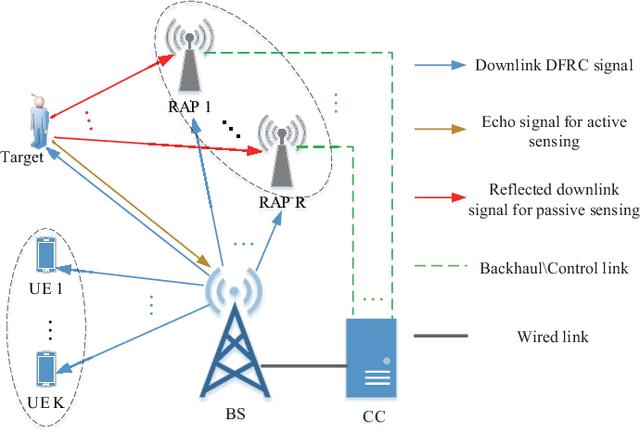


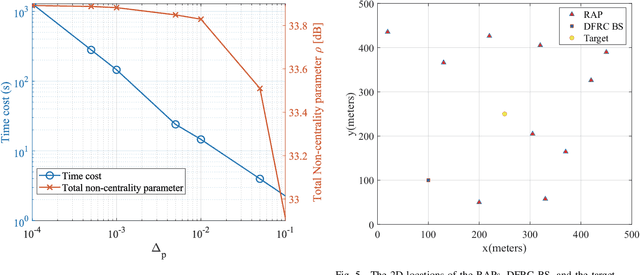
Abstract:Most existing works on dual-function radar-communication (DFRC) systems mainly focus on active sensing, but ignore passive sensing. To leverage multi-static sensing capability, we explore integrated active and passive sensing (IAPS) in DFRC systems to remedy sensing performance. The multi-antenna base station (BS) is responsible for communication and active sensing by transmitting signals to user equipments while detecting a target according to echo signals. In contrast, passive sensing is performed at the receive access points (RAPs). We consider both the cases where the capacity of the backhaul links between the RAPs and BS is unlimited or limited and adopt different fusion strategies. Specifically, when the backhaul capacity is unlimited, the BS and RAPs transfer sensing signals they have received to the central controller (CC) for signal fusion. The CC processes the signals and leverages the generalized likelihood ratio test detector to determine the present of a target. However, when the backhaul capacity is limited, each RAP, as well as the BS, makes decisions independently and sends its binary inference results to the CC for result fusion via voting aggregation. Then, aiming at maximize the target detection probability under communication quality of service constraints, two power optimization algorithms are proposed. Finally, numerical simulations demonstrate that the sensing performance in case of unlimited backhaul capacity is much better than that in case of limited backhaul capacity. Moreover, it implied that the proposed IAPS scheme outperforms only-passive and only-active sensing schemes, especially in unlimited capacity case.
LIPEx -- Locally Interpretable Probabilistic Explanations -- To Look Beyond The True Class
Oct 07, 2023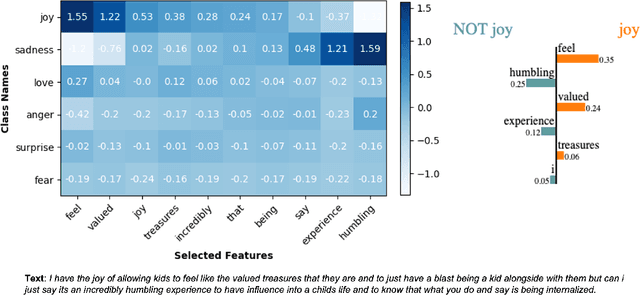

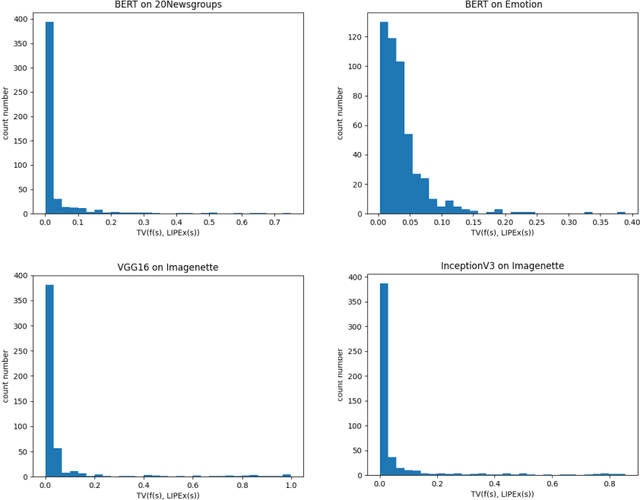

Abstract:In this work, we instantiate a novel perturbation-based multi-class explanation framework, LIPEx (Locally Interpretable Probabilistic Explanation). We demonstrate that LIPEx not only locally replicates the probability distributions output by the widely used complex classification models but also provides insight into how every feature deemed to be important affects the prediction probability for each of the possible classes. We achieve this by defining the explanation as a matrix obtained via regression with respect to the Hellinger distance in the space of probability distributions. Ablation tests on text and image data, show that LIPEx-guided removal of important features from the data causes more change in predictions for the underlying model than similar tests on other saliency-based or feature importance-based XAI methods. It is also shown that compared to LIME, LIPEx is much more data efficient in terms of the number of perturbations needed for reliable evaluation of the explanation.
Gradient Sparsification for Efficient Wireless Federated Learning with Differential Privacy
Apr 09, 2023Abstract:Federated learning (FL) enables distributed clients to collaboratively train a machine learning model without sharing raw data with each other. However, it suffers the leakage of private information from uploading models. In addition, as the model size grows, the training latency increases due to limited transmission bandwidth and the model performance degrades while using differential privacy (DP) protection. In this paper, we propose a gradient sparsification empowered FL framework over wireless channels, in order to improve training efficiency without sacrificing convergence performance. Specifically, we first design a random sparsification algorithm to retain a fraction of the gradient elements in each client's local training, thereby mitigating the performance degradation induced by DP and and reducing the number of transmission parameters over wireless channels. Then, we analyze the convergence bound of the proposed algorithm, by modeling a non-convex FL problem. Next, we formulate a time-sequential stochastic optimization problem for minimizing the developed convergence bound, under the constraints of transmit power, the average transmitting delay, as well as the client's DP requirement. Utilizing the Lyapunov drift-plus-penalty framework, we develop an analytical solution to the optimization problem. Extensive experiments have been implemented on three real life datasets to demonstrate the effectiveness of our proposed algorithm. We show that our proposed algorithms can fully exploit the interworking between communication and computation to outperform the baselines, i.e., random scheduling, round robin and delay-minimization algorithms.
One-to-Many Semantic Communication Systems: Design, Implementation, Performance Evaluation
Sep 20, 2022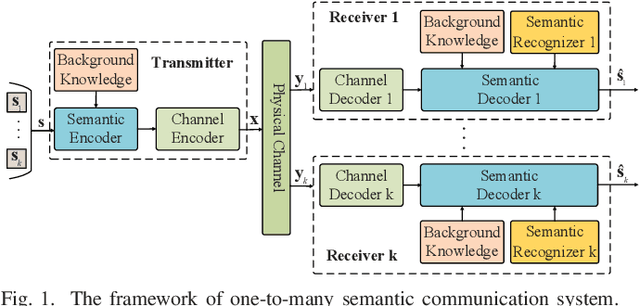
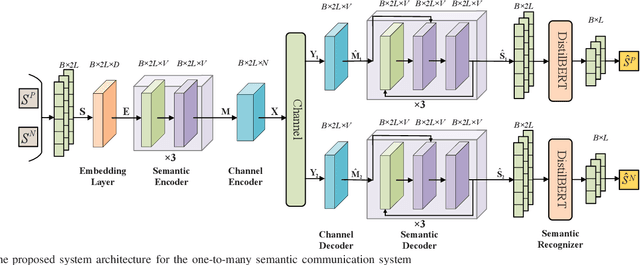


Abstract:Semantic communication in the 6G era has been deemed a promising communication paradigm to break through the bottleneck of traditional communications. However, its applications for the multi-user scenario, especially the broadcasting case, remain under-explored. To effectively exploit the benefits enabled by semantic communication, in this paper, we propose a one-to-many semantic communication system. Specifically, we propose a deep neural network (DNN) enabled semantic communication system called MR\_DeepSC. By leveraging semantic features for different users, a semantic recognizer based on the pre-trained model, i.e., DistilBERT, is built to distinguish different users. Furthermore, the transfer learning is adopted to speed up the training of new receiver networks. Simulation results demonstrate that the proposed MR\_DeepSC can achieve the best performance in terms of BLEU score than the other benchmarks under different channel conditions, especially in the low signal-to-noise ratio (SNR) regime.
 Add to Chrome
Add to Chrome Add to Firefox
Add to Firefox Add to Edge
Add to Edge